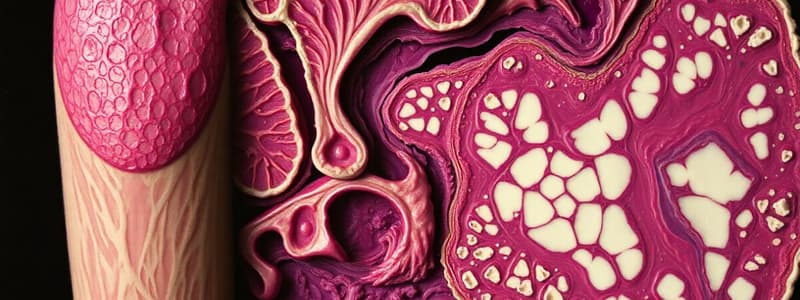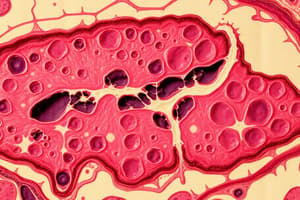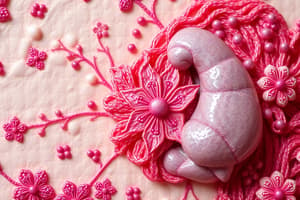Podcast
Questions and Answers
Which type of tissue is specialized for exchange with the environment?
Which type of tissue is specialized for exchange with the environment?
- Nervous tissue
- Epithelial tissue (correct)
- Connective tissue
- Muscular tissue
Connective tissue only connects organs together and does not support the body.
Connective tissue only connects organs together and does not support the body.
False (B)
What is the scientific study of tissues called?
What is the scientific study of tissues called?
Histology
Desmosomes connect adjacent cells and resist ________.
Desmosomes connect adjacent cells and resist ________.
Which type of cell junction is described as creating leakproof connections?
Which type of cell junction is described as creating leakproof connections?
Match the type of tissue with its primary function:
Match the type of tissue with its primary function:
What type of junction involves a plaque connecting transmembrane proteins to microfilaments?
What type of junction involves a plaque connecting transmembrane proteins to microfilaments?
Muscular tissue is made of specialized cells that ________ to generate force.
Muscular tissue is made of specialized cells that ________ to generate force.
Which type of membrane secretes synovial fluid to lubricate joints?
Which type of membrane secretes synovial fluid to lubricate joints?
Mucous membranes line body cavities that are not open to the external environment.
Mucous membranes line body cavities that are not open to the external environment.
What type of muscle tissue is under involuntary control and makes up the heart wall?
What type of muscle tissue is under involuntary control and makes up the heart wall?
The connective layer beneath the epithelial layer of mucous membranes is called the _____________.
The connective layer beneath the epithelial layer of mucous membranes is called the _____________.
Match the type of muscular tissue with its characteristics:
Match the type of muscular tissue with its characteristics:
Which type of exocrine gland secretes products via exocytosis from the apical surface only?
Which type of exocrine gland secretes products via exocytosis from the apical surface only?
All exocrine glands are classified as multicellular.
All exocrine glands are classified as multicellular.
What component makes up the extracellular matrix in connective tissue?
What component makes up the extracellular matrix in connective tissue?
Merocrine glands secrete by __________.
Merocrine glands secrete by __________.
Which type of connective tissue includes cells that are sparsely distributed and can maintain a gel-like ground substance?
Which type of connective tissue includes cells that are sparsely distributed and can maintain a gel-like ground substance?
Name one type of protein fibre found in the extracellular matrix.
Name one type of protein fibre found in the extracellular matrix.
Match the following types of connective tissues with their characteristics:
Match the following types of connective tissues with their characteristics:
Epithelial tissue is vascularized, while connective tissue is not.
Epithelial tissue is vascularized, while connective tissue is not.
Cells of connective tissue descend from __________ cells.
Cells of connective tissue descend from __________ cells.
Which of the following glands collect products in the cytosol and release mature cells by rupturing?
Which of the following glands collect products in the cytosol and release mature cells by rupturing?
What type of cartilage is most abundant in the body?
What type of cartilage is most abundant in the body?
Dense irregular connective tissue is found in the fasciae and resists pulling in one specific direction.
Dense irregular connective tissue is found in the fasciae and resists pulling in one specific direction.
What is the primary function of adipose connective tissue?
What is the primary function of adipose connective tissue?
What is the main function of hemidesmosomes?
What is the main function of hemidesmosomes?
____ connective tissue provides elasticity to organs such as the trachea and the walls of elastic arteries.
____ connective tissue provides elasticity to organs such as the trachea and the walls of elastic arteries.
The basement membrane consists of three layers: the basal lamina, reticular lamina, and transitional layer.
The basement membrane consists of three layers: the basal lamina, reticular lamina, and transitional layer.
What type of junction specializes in communication between adjacent cells?
What type of junction specializes in communication between adjacent cells?
Match the following types of connective tissues with their primary characteristic:
Match the following types of connective tissues with their primary characteristic:
Which characteristic is NOT associated with fibrocartilage?
Which characteristic is NOT associated with fibrocartilage?
Simple cuboidal epithelium is specialized for the secretion of __________ and __________.
Simple cuboidal epithelium is specialized for the secretion of __________ and __________.
The stroma refers to the filtering framework in organs like the spleen and lymph nodes.
The stroma refers to the filtering framework in organs like the spleen and lymph nodes.
Match the type of epithelial tissue with its function:
Match the type of epithelial tissue with its function:
Which type of epithelial tissue is specialized for protection and can be keratinized?
Which type of epithelial tissue is specialized for protection and can be keratinized?
What type of liquid connective tissue is primarily involved in nutrient and gas transport throughout the body?
What type of liquid connective tissue is primarily involved in nutrient and gas transport throughout the body?
Non-ciliated pseudostratified columnar epithelium has nuclei at different depths, making it appear stratified.
Non-ciliated pseudostratified columnar epithelium has nuclei at different depths, making it appear stratified.
The central canal within an osteon contains ____ and ____.
The central canal within an osteon contains ____ and ____.
What distinguishes elastic connective tissue from other types?
What distinguishes elastic connective tissue from other types?
What is the primary function of endocrine glands?
What is the primary function of endocrine glands?
The superficial layer of cells in stratified epithelial tissues can be __________ off.
The superficial layer of cells in stratified epithelial tissues can be __________ off.
What type of epithelium is specialized to stretch and is found in the bladder?
What type of epithelium is specialized to stretch and is found in the bladder?
Flashcards are hidden until you start studying
Study Notes
Definition and Types of Tissues
- Tissues consist of groups of cells originating from a common progenitor, functioning together.
- Four primary types of human tissues:
- Epithelial
- Connective
- Muscular
- Nervous
- The scientific study of tissues is known as histology.
General Functions of Human Tissues
- Epithelial Tissue:
- Acts as a protective barrier covering the body and lining hollow organs.
- Forms glands and is specialized for exchanging substances with the environment.
- Connective Tissue:
- Protects and supports body structures; connects and stores energy; aids in immunity.
- Muscular Tissue:
- Comprised of specialized cells that contract to produce force and generate heat.
- Nervous Tissue:
- Detects stimuli and generates electrical signals (nerve impulses) to stimulate muscle or gland activity.
Cell Junctions
- Cell junctions are contact points between adjacent cells, crucial for tissue integrity.
- Five main types of cell junctions:
- Tight junctions
- Adherens junctions
- Desmosomes
- Hemidesmosomes
- Gap junctions
Types of Cell Junctions
-
Tight Junctions:
- Create leakproof connections through transmembrane proteins; found in the stomach lining and urinary bladder.
-
Adherens Junctions:
- Connect adjacent cells, use transmembrane proteins linked to microfilaments to resist pulling forces.
-
Desmosomes:
- Similar to adherens, connect cells and resist mechanical stress; important in skin and heart muscle.
-
Hemidesmosomes:
- Anchor cells to the basement membrane using glycoproteins, resistant to abrasion.
-
Gap Junctions:
- Connect adjacent cell membranes via protein channels (connexons), allowing signal exchange for coordinated function.
Epithelial Tissue
- General Functions:
- Protects against injuries and moisture loss; participates in secretion and absorption.
- Structure Description:
- Classified by the number of layers (simple or stratified) and cell shape (squamous, cuboidal, columnar, transitional).
- Surface Epithelia:
- Lines body surfaces; glandular epithelium forms glands.
Classification of Epithelial Tissue
-
Layers:
- Simple: single layer
- Stratified: multiple layers
- Pseudostratified: appears multilayered but is single-layered.
-
Shapes:
- Squamous: flat cells
- Cuboidal: cube-like
- Columnar: tall, rectangular
- Transitional: varies with stretching.
Specific Types of Epithelial Tissue
-
Simple Squamous:
- Specialized for filtration and diffusion; found in lining blood vessels (endothelium) and serous membranes (mesothelium).
-
Simple Cuboidal:
- Found in kidney tubules and glands for secretion and absorption.
-
Simple Columnar:
- Non-ciliated (goblet cells) involved in secretion and absorption; found in the gastrointestinal tract.
-
Ciliated Columnar:
- Moves mucus and debris; found in bronchi and oviducts.
-
Stratified Squamous:
- Offers protection against abrasion; keratinized (skin) or non-keratinized (vagina).
-
Stratified Cuboidal and Columnar:
- Rare types found in certain glandular ducts.
-
Transitional Epithelium:
- Allows stretching; lines the urinary bladder and ureters.
Glandular Epithelium
-
Classifies glands into exocrine (secrete into ducts) and endocrine (secrete into blood).
-
Exocrine Glands:
- Can be unicellular (goblet cells) or multicellular, releasing products via different methods (merocrine, apocrine, holocrine).
-
Endocrine Glands:
- Secrete hormones for homeostasis directly into blood.
Connective Tissue
- Composed of a sparse arrangement of cells embedded in an extracellular matrix (ECM), containing fibers and ground substance.
- Major types of cells include fibroblasts (most abundant), macrophages, plasma cells, mast cells, and adipocytes.
Components of Connective Tissue
- Extracellular Matrix (ECM):
- Provides structural and biochemical support; contains collagen, elastic, and reticular fibers.
- Fibroblasts:
- Responsible for producing ECM components.
Types of Connective Tissue
-
Loose Connective Tissue:
- Includes areolar, adipose, and reticular tissues (provides support).
-
Dense Connective Tissue:
- Regular (tendons and ligaments) and irregular (fasciae) types for strength and support.
-
Cartilage:
- Three types: hyaline (smooth surface at joints), fibrocartilage (strongest, found in intervertebral discs), elastic (flexibility in the ear).
Bone and Liquid Connective Tissues
-
Bone Tissue:
- Comprises compact (osteons) and spongy forms; serves structural roles.
-
Blood:
- Composed of plasma and cells, crucial for transport and immune functions.
-
Lymph:
- Contains lymphocytes, roles in fluid balance and immune response.
Anatomical Membranes
- Consist of epithelial and connective tissue layers; include mucous (protective), serous (reduce friction), cutaneous (skin), and synovial (lubricate joints).
Muscular and Nervous Tissues
-
Muscular Tissue:
- Generates movement and heat; comprised of three types: skeletal (voluntary), cardiac (involuntary), and smooth (involuntary).
-
Nervous Tissue:
- Composed of neurons and supportive glial cells; facilitates rapid communication within the body.### Skeletal Muscle Tissue
-
Long, multinucleate, striated structure.
-
Responsible for voluntary movement, posture maintenance, and heat generation.
-
Attaches to bones through tendons.
Cardiac Muscle Tissue
- Composed of branched, striated fibers with a single nucleus per cell.
- Cells connected by gap junctions, allowing rapid conduction of electrical signals.
- Functions under involuntary control.
- Forms the myocardium, which is the heart wall.
Smooth Muscle Tissue
- Features long, non-striated fibers within irregularly-shaped cells, each containing a single nucleus.
- Cells have thickened middles and are interconnected by gap junctions for coordinated involuntary contractions.
- Involved in peristalsis, airway constriction, and contractions of the urinary bladder and gallbladder.
Nervous Tissue
- Comprised of two main cell types:
- Neurons: Include a cell body, dendrites, and an axon, generating electrical signals or nerve impulses.
- Neuroglia: Support cells that do not produce electrical impulses, synthesizing myelin to enhance the speed of electrical signal transmission along neuronal axons.
Studying That Suits You
Use AI to generate personalized quizzes and flashcards to suit your learning preferences.




